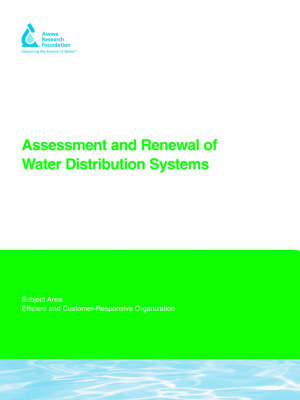Water Research Foundation Report
2 total works
Nationally, water utilities suffer some 250,000 to 300,000 main breaks yearly that cause total losses of about $3 billion per year. To mitigate these losses, utilities require effective strategies to assess condition, compute risk, and implement pipe renewal projects. Planning for mitigation requires valid estimates of the probability of failure, and providing these estimates has been the goal of a series of research projects, including this one.
The project team attempted to develop and test main break models. Efforts included data collection, data cleaning and quality control, verification, and application to utility case studies. The work clarified that the link between main break models and risk factors is in the predictor variables that show risk of breaks. The project was able to model some types of breaks in single utilities with a fair degree of confidence, but many questions remained about usefulness of results within the utilities. The project also produced guidance for quality assurance of main break data.
The project team attempted to develop and test main break models. Efforts included data collection, data cleaning and quality control, verification, and application to utility case studies. The work clarified that the link between main break models and risk factors is in the predictor variables that show risk of breaks. The project was able to model some types of breaks in single utilities with a fair degree of confidence, but many questions remained about usefulness of results within the utilities. The project also produced guidance for quality assurance of main break data.
Water utilities use their distribution systems to deliver high quality water to customers in spite of breaks, corrosive deterioration, and other forces. These aging and invisible water distribution networks, spread over large areas with multiple connections and points-of-access, require large allocations of capital resources for renewal. Needs studies began to appear around 1980 after implementation of the Safe Drinking Water Act converged with emerging awareness of national infrastructure investment needs and with the ramp-up of AwwaRF programs. To succeed in capital management, utilities must locate, assess, plan, repair, and renew their water distribution systems. However, management technologies for these tasks are in flux and utilities require guidance. The objectives of this project were to synthesize the knowledge base on condition assessment, repair and rehabilitation, and prioritization; to expand the knowledge base to lead to optimal capital management strategies for utilities; to help plan a responsive research agenda for the water supply industry; to help utilities use results of research projects; and to provide a critical evaluation and an assessment of requirements for implementing tools. The project included a synthesis of the knowledge base, interviews with utilities, and three workshops, including an international workshop. A number of working papers and workshop summaries were prepared, and the project results have been merged into the final report. An ?issue tree? is used to show the components of the management problem and to provide a structure for analysis of problems. It shows the what, why, who, how, and when of the management problem. The report offers a framework for condition assessment to provide a common ground to exchange information. This is consistent with the findings in the field of benchmarking, where common definitions and measures are required. The framework adapts to system components and subsystems, to the technical and management sides of the organization, and to capital and operating components. It also links the parameters of condition assessment with the uses of the information for renewal work by operators, engineers, maintenance personnel, and by budget and finance staff. The report describes how utility tasks in planning and prioritization span a spectrum from problem assessment to making decisions about solutions. It focuses on the prioritization process, as it fits into the capital planning process. It explains how, in prioritization, utilities face the dual problem of identifying their highest priority pipe renewal projects and comparing them to other capital investments, which are often more visible and attractive. The most direct way to evaluate fragility is with condition assessment technologies and direct inspection techniques. However, the sheer magnitude of buried pipe and the difficulty in accessing pipe make this problematic and this area needs more research. The report describes how practices among utilities vary greatly in repair, rehabilitation, and replacement. At the project workshop, participants observed that North American water utilities are reluctant to use newer technologies for pipe renewal. Reasons are lack of awareness, cost effectiveness, liability, and uncertainty about sustainability. Options to speed adoption of new technologies were cost reduction by assembling larger projects; providing training; providing education for management, politicians, and customers about benefits of new technologies; and using the private sector for construction of renewals. The report describes how, for rehabilitation, utilities can choose from a family of non-structural or semi-structural lining techniques, or they can replace a pipe with a new structural liner or pipe bursting, followed by insertion of new pipe. It also discusses the daunting aspect of the renewal problem. The problem is much more complex than other pipe scenarios due to congestion, pressurization, hidden assets, age, water quality, and service connections. In summary, the report discusses the issues faced by utilities in renewal and the options they have. The report provides comprehensive guidance to utilities about how to assess options for distribution system renewal. It will enable utility capital managers to review rapidly the knowledge base on condition assessment, planning and prioritization, and renewal methods. Although AwwaRF has sponsored a number of projects on distribution systems, the report identifies additional projects that are required. Originally published by AwwaRF for its subscribers in 2004. This publication can also be purchased and downloaded via Pay Per View on Water Intelligence Online - click on the Pay Per View icon below

